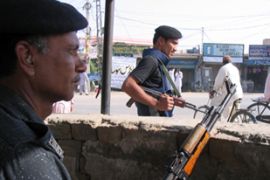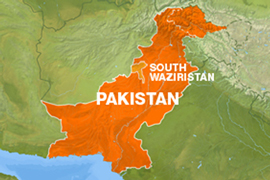Threats close Pakistan schools
Closures follow threats by Taliban as military steps up offensive in South Waziristan.

“People actually don’t want to go to work,” he said.
Al Jazeera’s Alan Fisher, reporting from Islamabad, said government officials feared that schools could be targeted by suicide bombers, or that pupils could be taken hostage by those threatening to blow the school up.
“We have no way of confirming whether or not the threats were made by the Taliban, but the threat was enough for the Pakistani government to take this action,” he said.
Offensive
| In depth | |||||||||||||||
|
The Pakistani military launched its first major offensive against the Taliban in South Waziristan region bordering Afghanistan on Saturday.
A spokesperson for the Taliban has vowed the group will fight to the “last drop of blood”, and both sides have said they are gaining the upper hand.
On Sunday the military said it had seized key Taliban bases during the first 24 hours of fighting which saw at least five soldiers and 60 Taliban fighters killed.
But the Taliban also claims it has inflicted heavy casualties on the Pakistani army, pushing them back into their bases.
As many as 150,000 civilians have left the area in recent months after the army made clear it was planning an assault.
Around 350,000 others are estimated to still be in the region.
Security forces said they had captured key Taliban strongholds on Saturday after the fighters withdrew from their fortifications and took refuge in nearby mountains, officials said.
The army says about 28,000 soldiers are battling an estimated 10,000 Taliban fighters, including about 1,000 Uzbeks and some Arab al-Qaeda members.
Attacks
| Facts: South Waziristan |
|
|
The Pakistani offensive comes after a series of bomb attacks across the country over the past two weeks that have killed more than 170 people.
In the latest attack, at least 11 people died in two explosions near a police office in the northwestern city of Peshawar on Friday.
Al Jazeera’s Imran Khan, reporting from in Islamabad, said police believed the string attacks across Pakistan had been planned from South Waziristan where Hakimullah Mehsud, the leader of the Pakistani Taliban, is based.
“So this is a crucial operation to decapitate the head of the senior Pakistani Taliban leadership,” he said.
“But there is always the problem that if you squeeze the Taliban in one area, they pop up in another.”
Speaking to Al Jazeera, Hamid Nawaz, a former Pakistani general and military-affairs analyst, said he believed the army could complete its operations before the December snowfall.
“This is not going to be a set-piece battle … the theatre of operations is only about 6,000km sq and there will only be pockets of resistance.
“And efforts have been made to co-ordinate attacks with Nato troops as well as the Afghan army on the other side of the border to prevent anyone escaping.”


 The district in the Federally Administered Tribal Area (FATA) borders Afghanistan, North Waziristan, the North-West Frontier Province and Baluchistan
The district in the Federally Administered Tribal Area (FATA) borders Afghanistan, North Waziristan, the North-West Frontier Province and Baluchistan